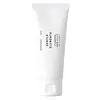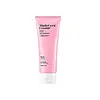What's inside
What's inside
 Key Ingredients
Key Ingredients

 Benefits
Benefits

 Concerns
Concerns

 Ingredients Side-by-side
Ingredients Side-by-side

Water
Skin ConditioningGlycerin
HumectantSodium Cocoyl Isethionate
CleansingCoco-Betaine
CleansingStearyl Alcohol
EmollientGlyceryl Stearate
EmollientSodium Methyl Cocoyl Taurate
CleansingSodium Chloride
MaskingMoringa Oleifera Seed Oil
EmollientAscorbyl Glucoside
AntioxidantAscorbic Acid
AntioxidantTremella Fuciformis Extract
HumectantOryza Sativa Extract
AbsorbentSaccharide Isomerate
HumectantSodium Hyaluronate
HumectantHyaluronic Acid
HumectantAdenosine
Skin ConditioningCurcuma Longa Root Extract
MaskingQuillaja Saponaria Bark Extract
CleansingMelia Azadirachta Flower Extract
Skin ConditioningMelia Azadirachta Leaf Extract
Skin ConditioningOcimum Sanctum Leaf Extract
Skin ConditioningCorallina Officinalis Extract
Skin ConditioningNiacinamide
SmoothingBetaine
HumectantTrehalose
HumectantMannitol
HumectantCitric Acid
BufferingKaolin
AbrasiveCoco-Glucoside
CleansingMicrocrystalline Cellulose
AbsorbentCeramide NP
Skin ConditioningHydrogenated Lecithin
EmulsifyingGlycine
BufferingSerine
MaskingGlutamic Acid
HumectantPhytosphingosine
Skin ConditioningAspartic Acid
MaskingLeucine
Skin ConditioningAlanine
MaskingLysine
Skin ConditioningArginine
MaskingTyrosine
MaskingPhenylalanine
MaskingProline
Skin ConditioningThreonine
Valine
MaskingIsoleucine
Skin ConditioningHistidine
HumectantCysteine
AntioxidantMethionine
Skin ConditioningDiamond Powder
Abrasive1,2-Hexanediol
Skin ConditioningSodium Phytate
Sodium Citrate
BufferingZea Mays Starch
AbsorbentHydroxypropyl Starch Phosphate
Butylene Glycol
HumectantCaprylyl Glycol
EmollientCitrus Aurantium Bergamia Fruit Oil
MaskingRosmarinus Officinalis Leaf Oil
MaskingPinus Sylvestris Leaf Oil
MaskingLavandula Angustifolia Oil
MaskingWater, Glycerin, Sodium Cocoyl Isethionate, Coco-Betaine, Stearyl Alcohol, Glyceryl Stearate, Sodium Methyl Cocoyl Taurate, Sodium Chloride, Moringa Oleifera Seed Oil, Ascorbyl Glucoside, Ascorbic Acid, Tremella Fuciformis Extract, Oryza Sativa Extract, Saccharide Isomerate, Sodium Hyaluronate, Hyaluronic Acid, Adenosine, Curcuma Longa Root Extract, Quillaja Saponaria Bark Extract, Melia Azadirachta Flower Extract, Melia Azadirachta Leaf Extract, Ocimum Sanctum Leaf Extract, Corallina Officinalis Extract, Niacinamide, Betaine, Trehalose, Mannitol, Citric Acid, Kaolin, Coco-Glucoside, Microcrystalline Cellulose, Ceramide NP, Hydrogenated Lecithin, Glycine, Serine, Glutamic Acid, Phytosphingosine, Aspartic Acid, Leucine, Alanine, Lysine, Arginine, Tyrosine, Phenylalanine, Proline, Threonine, Valine, Isoleucine, Histidine, Cysteine, Methionine, Diamond Powder, 1,2-Hexanediol, Sodium Phytate, Sodium Citrate, Zea Mays Starch, Hydroxypropyl Starch Phosphate, Butylene Glycol, Caprylyl Glycol, Citrus Aurantium Bergamia Fruit Oil, Rosmarinus Officinalis Leaf Oil, Pinus Sylvestris Leaf Oil, Lavandula Angustifolia Oil
Sea Water
HumectantGlycerin
HumectantMyristic Acid
CleansingWater
Skin ConditioningPalmitic Acid
EmollientPotassium Hydroxide
BufferingLauric Acid
CleansingGlyceryl Stearate
Emollient1,2-Hexanediol
Skin ConditioningPotassium Cocoyl Glycinate
Hydrolyzed Collagen
EmollientOlea Europaea Fruit Oil
MaskingButyrospermum Parkii Butter
Skin ConditioningSqualane
EmollientCeramide NP
Skin ConditioningAlanine
MaskingSerine
MaskingPCA
HumectantDipropylene Glycol
HumectantCholesterol
EmollientAsiaticoside
AntioxidantMadecassic Acid
Skin ConditioningPhytosphingosine
Skin ConditioningAsiatic Acid
Skin ConditioningMadecassoside
AntioxidantPortulaca Oleracea Extract
Skin ConditioningTilia Europaea Flower Extract
Skin ConditioningHamamelis Virginiana Extract
AntiseborrhoeicCitrus Aurantium Dulcis Peel Oil
MaskingPelargonium Graveolens Flower Oil
MaskingRosmarinus Officinalis Leaf Extract
AntimicrobialViola Odorata Flower Extract
MaskingAbelmoschus Esculentus Fruit Extract
Skin ConditioningAloe Barbadensis Leaf Extract
EmollientUlmus Davidiana Root Extract
Skin ConditioningAlgae Oligosaccharides
Skin ConditioningCitrus Limon Peel Oil
MaskingStearic Acid
CleansingPolyquaternium-7
Disodium EDTA
Sodium Benzoate
MaskingButylene Glycol
HumectantCapric Acid
CleansingHydrogenated Lecithin
EmulsifyingCaprylic/Capric Triglyceride
MaskingCitronellol
PerfumingLimonene
PerfumingSea Water, Glycerin, Myristic Acid, Water, Palmitic Acid, Potassium Hydroxide, Lauric Acid, Glyceryl Stearate, 1,2-Hexanediol, Potassium Cocoyl Glycinate, Hydrolyzed Collagen, Olea Europaea Fruit Oil, Butyrospermum Parkii Butter, Squalane, Ceramide NP, Alanine, Serine, PCA, Dipropylene Glycol, Cholesterol, Asiaticoside, Madecassic Acid, Phytosphingosine, Asiatic Acid, Madecassoside, Portulaca Oleracea Extract, Tilia Europaea Flower Extract, Hamamelis Virginiana Extract, Citrus Aurantium Dulcis Peel Oil, Pelargonium Graveolens Flower Oil, Rosmarinus Officinalis Leaf Extract, Viola Odorata Flower Extract, Abelmoschus Esculentus Fruit Extract, Aloe Barbadensis Leaf Extract, Ulmus Davidiana Root Extract, Algae Oligosaccharides, Citrus Limon Peel Oil, Stearic Acid, Polyquaternium-7, Disodium EDTA, Sodium Benzoate, Butylene Glycol, Capric Acid, Hydrogenated Lecithin, Caprylic/Capric Triglyceride, Citronellol, Limonene
Ingredients Explained
These ingredients are found in both products.
Ingredients higher up in an ingredient list are typically present in a larger amount.
1,2-Hexanediol is a synthetic liquid and another multi-functional powerhouse.
It is a:
- Humectant, drawing moisture into the skin
- Emollient, helping to soften skin
- Solvent, dispersing and stabilizing formulas
- Preservative booster, enhancing the antimicrobial activity of other preservatives
Alanine is an amino acid and is already found in the human body. Our skin uses alanine to build collagen, elastin, and keratin.
Butylene Glycol (or BG) is used within cosmetic products for a few different reasons:
Overall, Butylene Glycol is a safe and well-rounded ingredient that works well with other ingredients.
Though this ingredient works well with most skin types, some people with sensitive skin may experience a reaction such as allergic rashes, closed comedones, or itchiness.
Learn more about Butylene GlycolCeramide NP is a type of ceramide and formally known as ceramide 3.
Ceramides are intercellular lipids naturally found in our skin that bonds dead skin cells together to create a barrier. They are known for their ability to hold water and thus are a great ingredient for dry skin.
Ceramides are an important building block for our skin barrier. A stronger barrier helps the skin look more firm and hydrated. By bolstering the skin ceramides act as a barrier against irritating ingredients. This can help with inflammation as well.
If you would like to eat ceramides, sweet potatoes contain a small amount.
Read more about other common types of ceramides here:
Ceramide AP
Ceramide EOP
Glycerin is already naturally found in your skin. It helps moisturize and protect your skin.
A study from 2016 found glycerin to be more effective as a humectant than AHAs and hyaluronic acid.
As a humectant, it helps the skin stay hydrated by pulling moisture to your skin. The low molecular weight of glycerin allows it to pull moisture into the deeper layers of your skin.
Hydrated skin improves your skin barrier; Your skin barrier helps protect against irritants and bacteria.
Glycerin has also been found to have antimicrobial and antiviral properties. Due to these properties, glycerin is often used in wound and burn treatments.
In cosmetics, glycerin is usually derived from plants such as soybean or palm. However, it can also be sourced from animals, such as tallow or animal fat.
This ingredient is organic, colorless, odorless, and non-toxic.
Glycerin is the name for this ingredient in American English. British English uses Glycerol/Glycerine.
Learn more about GlycerinGlyceryl Stearate is a mix of glycerin and stearic acid.
It is used to stabilize the mixing of water and oil ingredients. By preventing these ingredients from separating, it can help elongate shelf life. It can also help thicken the product's texture.
As an emollient, it helps soften skin and supports barrier-replenishing ingredients.
In cosmetics, Glyceryl Stearate is often made from vegetable oils or synthetically produced.
This ingredient may not be fungal-acne safe
Fun fact: The human body also creates Glyceryl Stearate naturally.
Learn more about Glyceryl StearateHydrogenated Lecithin is created from the hydrogenation of lecithin (a group of phospholipids). Hydrogenation is a chemical reaction between hydrogen and another element.
This ingredient is an emollient and emulsifier. As an emollient, it helps soften skin by trapping moisture within. As an emulsifier, it prevents oil and water ingredients from separating.
Phytosphingosine is a phospholipid naturally found in our skin as a building block for ceramides.. It helps moisturize, soothe, and protect skin.
Phytosphingosine contributes to your skin's natural moisturizing factor (NMF). The NMF is responsible for hydration, a strong barrier, and plasticity. Our NMF decreases with age. Increasing NMF leads to more healthy and hydrated skin.
Studies show products formulated with NMF ingredients help strengthen our skin's barrier. Having a healthy skin barrier reduces irritation and increases hydration. Our skin barrier is responsible for having plump and firm skin. It also helps protect our skin against infection, allergies, and inflammation.
Fun fact: Phytosphingosine is abundant in plants and fungi.
More ingredients that help boost collagen in skin:
Learn more about PhytosphingosineSerine is an amino acid naturally found in our body. Our bodies use amino acids to create protein.
Amino-acids help give keep our skin hydrated. They play an important role in the skin barrier, which keeps the skin plump and firm.
Serine is a non-essential amino acid, meaning we don't need to obtain it from eating foods.
Learn more about SerineWater. It's the most common cosmetic ingredient of all. You'll usually see it at the top of ingredient lists, meaning that it makes up the largest part of the product.
So why is it so popular? Water most often acts as a solvent - this means that it helps dissolve other ingredients into the formulation.
You'll also recognize water as that liquid we all need to stay alive. If you see this, drink a glass of water. Stay hydrated!
Learn more about Water